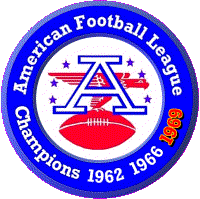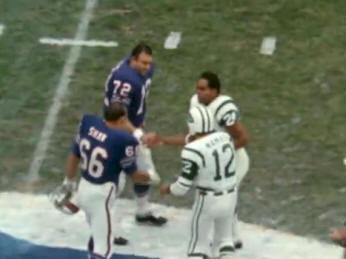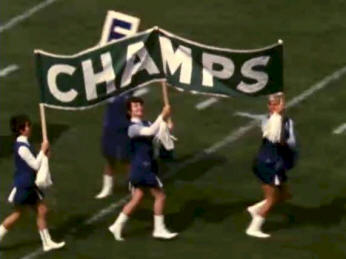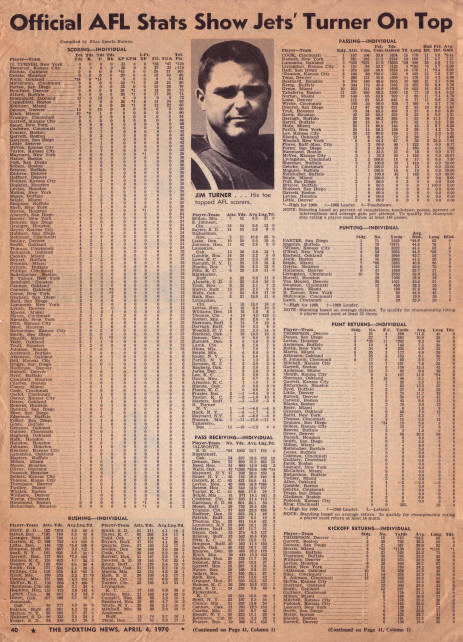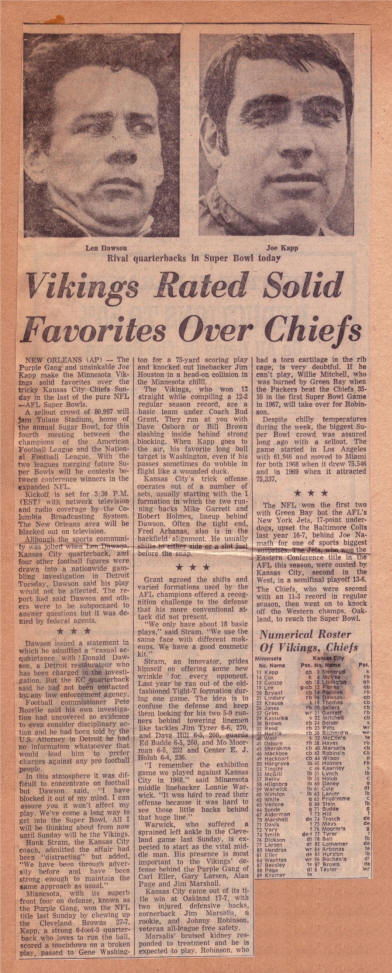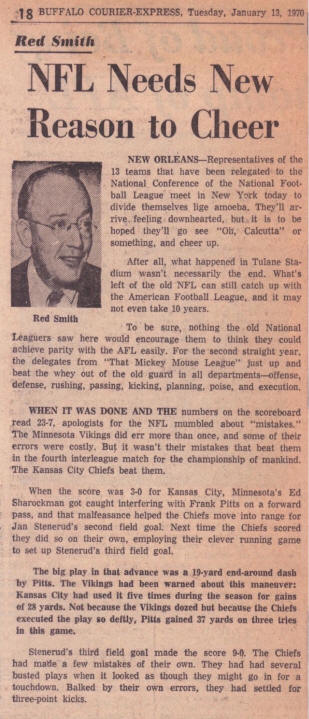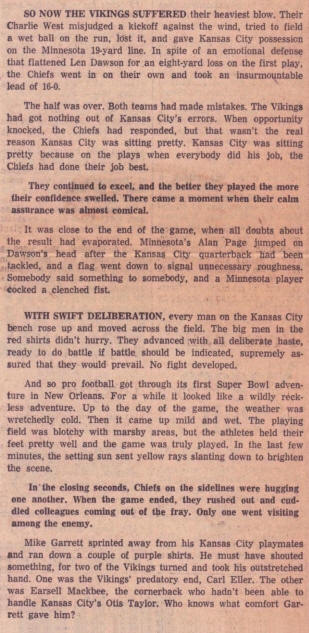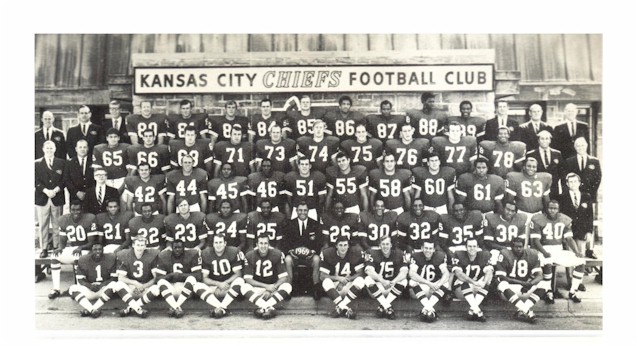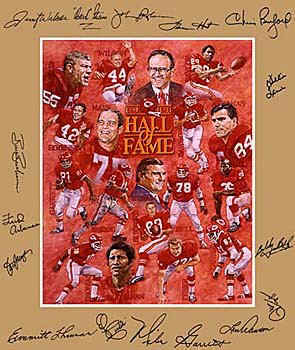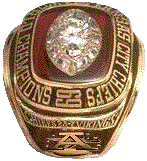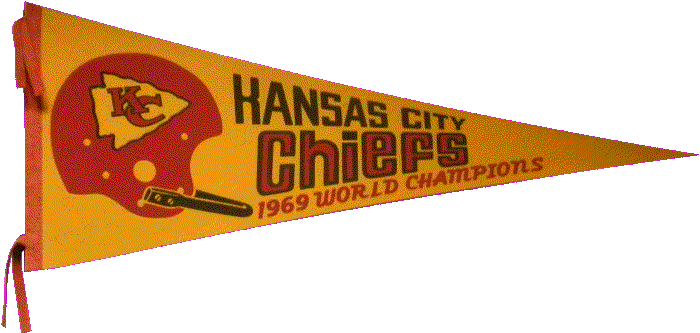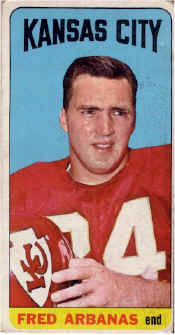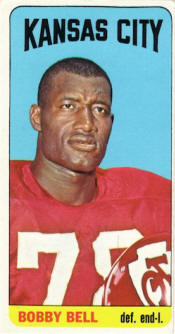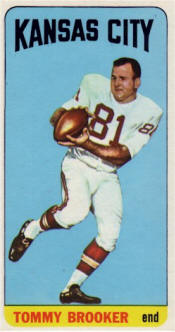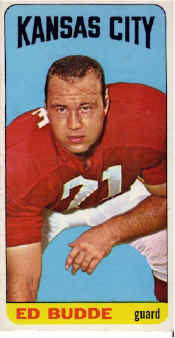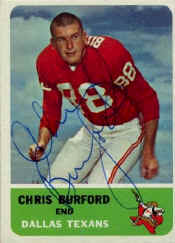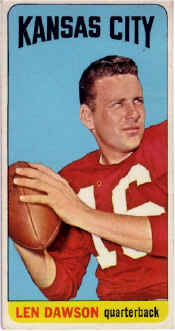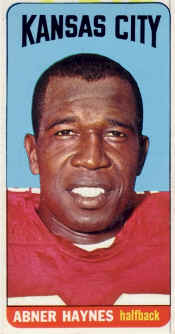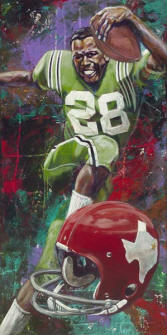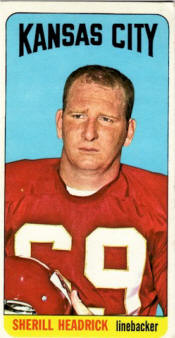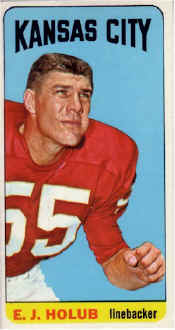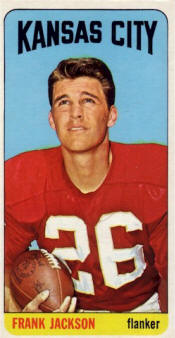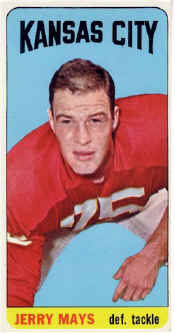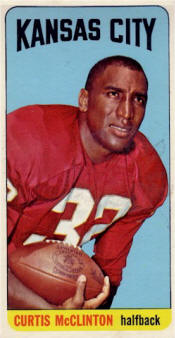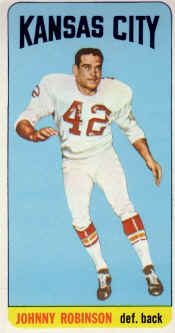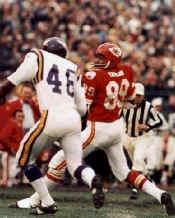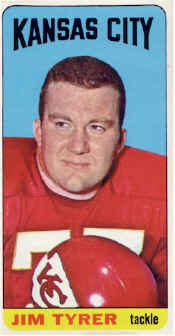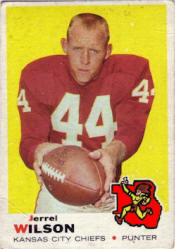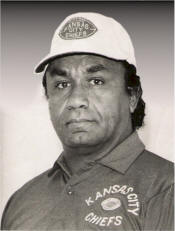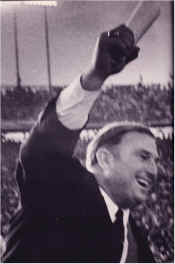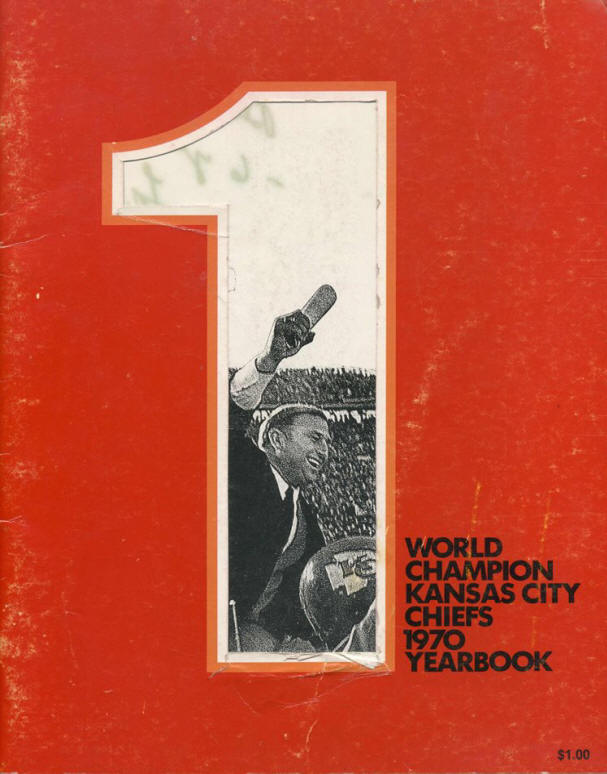Bobby Bell
attended the
University of
Minnesota,
where he was named an All-American and won the 1962
Outland Trophy
as the nation's outstanding interior lineman.
He was
drafted by the Chiefs in 1963 and
was an
AFL All-Star
for six straight years, 1964 through 1969. He was
on two AFL Championship teams and a World Championship
team. He was named to the
All-Time All-AFL Team
in 1970. He was inducted into the Chiefs Hall of
Fame in 1980, and the Pro Football Hall of Fame in 1983.
The Chiefs retired his uniform number 78. In 1999, he
was ranked number 66 on
The Sporting News'
list of the 100 Greatest Football Players.
Bell was noted for his
one-of-a-kind athleticism, and was called the most
physically gifted linebacker and one of the finest
open-field tacklers in professional football history,
because his speed at such a size made him ideal at his
position. He scored 9 tds in his career: 6 on
interceptions (26 in his career), 2 more on fumble
recoveries, and one on an onside kickoff return.
Coach Hank Stram said that "He could play all 22
positions on the field, and play them well."
|
|
|||||
|
|
|
|
|
||
| . | |||||
The 1969 American Football League Season and the . . .
 |
|
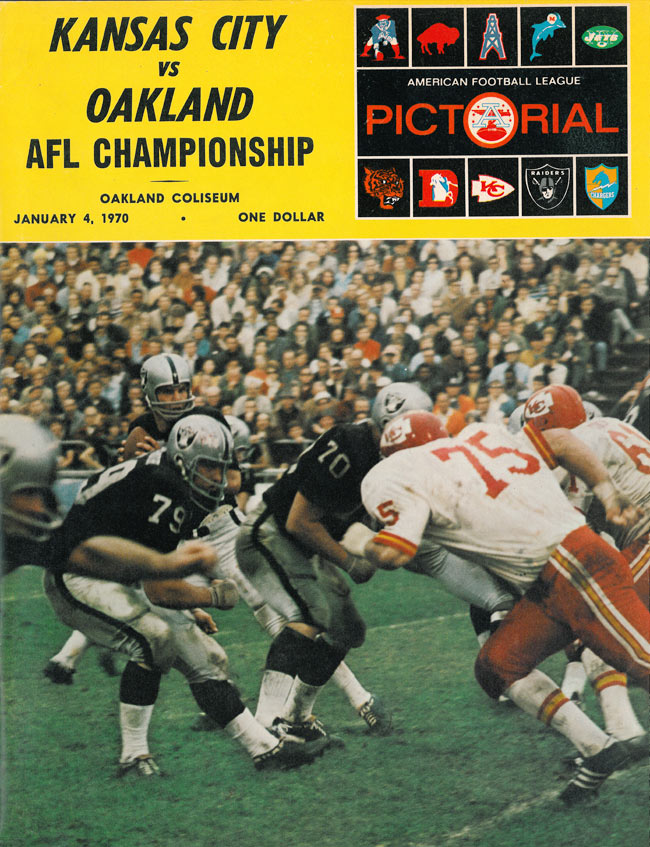 |
|
|
. |
|
|||||||
|
|||
|
|||
. |
|
All-Time Leaders through 1969 |
||
|
. |
|
PROFESSIONAL FOOTBALL'S LEADING LIFETIME
PASSERS |
|||||||||||||||||||||||||||||||||||||||||||||||||||||||||||||||||||||||||||||||||||||||||||||||||||||||||||||||||||||||||||||||||||||||||||||||||||||||||||||||||||||||||||||||||||||||||||||||||||||||
|
|||||||||||||||||||||||||||||||||||||||||||||||||||||||||||||||||||||||||||||||||||||||||||||||||||||||||||||||||||||||||||||||||||||||||||||||||||||||||||||||||||||||||||||||||||||||||||||||||||||||
. |
|
PROFESSIONAL FOOTBALL'S LEADING LIFETIME
RECEIVERS |
|||||||||||||||||||||||||||||||||||||||||||||||||||||||||||||||||||||||||||||||||||||||||||||||||||||||||||||||||||||||||||||||||||||||||||||||||||||||||||||||||||||||||||||||||||||||||||||||||||||||
|
|||||||||||||||||||||||||||||||||||||||||||||||||||||||||||||||||||||||||||||||||||||||||||||||||||||||||||||||||||||||||||||||||||||||||||||||||||||||||||||||||||||||||||||||||||||||||||||||||||||||
. |
|
PROFESSIONAL FOOTBALL'S LEADING LIFETIME
RUSHERS |
|||||||||||||||||||||||||||||||||||||||||||||||||||||||||||||||||||||||||||||||||||||||||||||||||||||||||||||||||||||||||||||||||||||||||||||||||||||||||||||||||||||||||||||||||||||||||||||||||||||||
|
|||||||||||||||||||||||||||||||||||||||||||||||||||||||||||||||||||||||||||||||||||||||||||||||||||||||||||||||||||||||||||||||||||||||||||||||||||||||||||||||||||||||||||||||||||||||||||||||||||||||
. |
|
PROFESSIONAL FOOTBALL'S LEADING LIFETIME
SCORERS |
|||||||||||||||||||||||||||||||||||||||||||||||||||||||||||||||||||||||||||||||||||||||||||||||||||||||||||||||||||||||||||||||||||||||||||||||||||||||||||||||||||||||||||||||||||||||||||||||||||||||
|
|||||||||||||||||||||||||||||||||||||||||||||||||||||||||||||||||||||||||||||||||||||||||||||||||||||||||||||||||||||||||||||||||||||||||||||||||||||||||||||||||||||||||||||||||||||||||||||||||||||||
. |
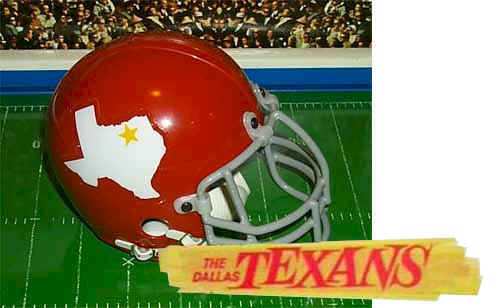 |
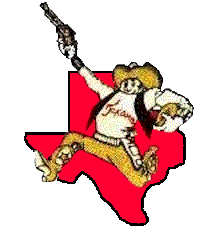 |
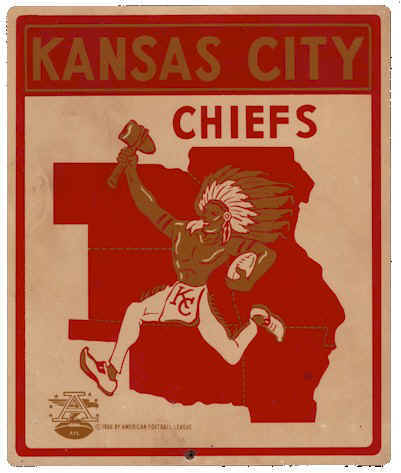 |
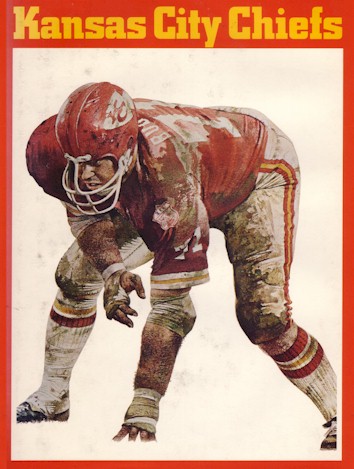
. |
. |
|||
|
Michigan State University's Fred Arbanas was the perfect tight end, not only because of his 6-foot-3 frame and 240 pounds of chiseled muscle. Drafted by the Chiefs in 1962, Arbanas was an American Football League All-Star in 1962, ' 63, '64, '65, and '67. Because of his heart and perseverance, he was the driving force behind one of the greatest teams in the history of the American Football League. He was the AFL's prototype tight end. His 198 receptions and 3,101 receiving yards are still the Chiefs records for the position. In 1964 he lost the vision in one eye, but he rebounded to give the Chiefs six more solid years. Arbanas starred for two Chiefs Super Bowl teams and used the playing field to write a legacy for the AFL. "I remember when the Chiefs played the Chicago Bears the summer after the loss to Green Bay in the first Super Bowl," team owner Lamar Hunt said. "We won the pre-season game 66-24, but there was a lot at stake in that game. I heard Fred say that was his most memorable game, and I feel the same way." His hard-nosed play and consummate skill earned a spot on the All-Time All-AFL Team. |
|

 |
|
| A
member of the American Football League Hall of Fame |
|
. |
|
|
|
|
|
| A
member of the American Football League Hall of Fame |
|
. |
|
In 1962, as a Dallas Texans rookie
from
Alabama, Tommy Brooker made all of his 33
extra-point attempts, and 12 field goals. His biggest score, however,
came as a 24-yard field goal to end the second sudden-death overtme period
in the 1962 American Football League Championship game. That game,
between the Texans and the two-time defending AFL champion Houston Oilers,
was the longest AFL game ever played. Brooker's field goal with
2:06 left in the second overtime gave the franchise its first of three
AFL Championships. Athough Brooker played only five years, he was second only to George Blanda in consecutive successful kicks for points after touchdowns, with 149. He made every PAT he attempted in those five years, never missing. Brooker also holds a share of the AFL record for consecutive field goals attempted and made in a game, eight. |
|
 |
. |
|
Ed Budde, a
product of Michigan State, was the No. 1 draft pick, for 1963, of the Dallas Texans.
The team became the Kansas City Chiefs before the 1963 season began. An
offensive guard, Budde went on to play for the Chiefs longer (14 years) than any other
player, with the exception of Hall of Fame punter Jerrell Wilson. Budde was huge: 6-foot-5
and 260 pounds; and his explosive blocks could spring a running back loose or keep
defenders away from the Chiefs signal-caller. He was selected to the AFL All-Star team in 1963, ‘66, ‘67, ‘68 and 1969, and he played in six AFL All-Star games. Budde was the first offensive lineman to be selected by the Associated Press as an Offensive Player of the Week. As the heart of the Chiefs’ offensive line, his overpowering presence helped the Chiefs to win two American Football League Championships (1966 and 1969) and a World Championship in Super Bowl IV. Budde is a member of the All-Time All-AFL Team. |
|

 |
|
| A
member of the American Football League Hall of Fame |
|
|
. |
A member of the STANFORD Athletic Hall of Fame and the College Football Hall of Fame, Chris Burford was a master of sideline receptions for the Dallas Texans and Kansas City Chiefs. What he lacked in great speed or physical presence, he made up for by running perfectly choreographed pass routes that outsmarted most American Football League defensive backs. An AFL All-Star in 1961, he followed that performance with 12 receptions for touchdowns in 1962, leading the league. By the end of his career he was the Chiefs all-time reception leader (391) with 5,505 yards and 55 touchdowns.Teaming with Hall of Famer Len Dawson, Burford was a clutch receiver when the game was on the line and the ball had to be moved forward for a needed first down or for field-goal position. For most of his AFL career, Burford was in the top ten in receiving catches, yards, and touchdowns. Burford is a 1974 inductee of the Chiefs' Hall of Fame. |
|

 |
|
| A
member of the American Football League Hall of Fame |
|
. |
Purdue’s Len Dawson - another so-called “NFL reject” who showed that the league’s talent evaluators blundered when they decided certain players weren’t “good enough” to play in the NFL. In his first year in the American Football League, Dawson led his Dallas Texans to a double-overtime victory over the two-time defending American Football League Champion Houston Oilers. The game was a classic, and Dawson ran a ball-control offense for a 17-14 win. Dawson had a 28-yard touchdown pass to Hall of Fame halfback Abner Haynes. In his first season, 1962, Dawson had led the league in touchdowns and yards per attempt. He was the Sporting News selection as the AFL MVP for 1962. A pinpoint passer with four AFL passing titles, he went on to be selected an AFL All-Star six times, and holds the American Football League’s number one career passer rating. He quarterbacked his team to three American Football League championships.Dawson was the MVP in the Fourth AFL-NFL World Championship game, the last game ever played by an American Football League team. He led the league out in glory, defeating the heavily-favored Vikings, who, like the Colts of the previous year, had been touted as “the best team in pro football history”. |
|

 |
A member of the |
. |
| Dave Grayson played offensive and defensive halfback at the University of Oregon. He was drafted by the Dallas Texans in 1961 and played four years with the Texans/Chiefs before joining the Oakland Raiders in 1965. Grayson held the AFL record for longest interception return for a td, 99 yds against the New York Titans in 1961. He had an interception off George Blanda in the Texans' classic 1962 double-overtime championship game victory over the defending AFL Champion Houston Oilers. Grayson was All-AFL in Dallas/Kansas City in 1962, 1963 and 1964, and in Oakland in 1965 and 1967, when he again played on an AFL Championship team. He is the all-time AFL leader in interceptions with 47, for a 20-yard return average and 5 tds, and he averaged 25.4 yards on 110 kickoff returns. He is a member of the American Football League All-Time Team. | |

 |
A member of the American Football League Hall of Fame |
. |
ABNER HAYNES |
In 1956 Abner Haynes attended North Texas State University (now the University of North Texas), where he helped make the school one of the first in Texas to integrate its football program. In 1960, Haynes chose to play for the Dallas Texans and led the American Football League in rushing attempts, yards, and TDs in the league’s first year. Haynes helped launch the AFL in 1960, when he was the fledgling league's first Most Valuable Player, and its first Rookie of the Year. He captured the AFL's first rushing crown with 875 yards, and also led the Texans in receiving, punt returns, and kickoff returns. Haynes spent three years in Dallas and two with the Kansas City Chiefs. Haynes still owns 11 franchise records, including most points in a game (30), most touchdowns in a season (19), most touchdowns in a game (5), most career 100-yard rushing games (12), most career rushing touchdowns (39) and most career combined yards (8,442). Over his career he was regularly among the American Football League's top ten rushers, ranking third all-time, and the all-time leader in touchdowns, with 46. He was Hall of Fame head coach Hank Stram's most versatile and dangerous weapon from 1960-62, amassing 43 touchdowns and 4,472 yards on rushes and receptions. In 1962, he helped the Texans win the American Football League championship in the classic double-overtime victory over the defending champion Houston Oilers, scoring touchdowns on a 28-yard pass reception from quarterback Len Dawson, and on a 2-yard run."He was a franchise player before they talked about franchise players," praised Stram. "He did it all - rushing, receiving, kickoff returns, punt returns. He gave us the dimension we needed to be a good team in Dallas." The 6-foot-1, 200-pound Haynes, who had great speed and dazzling moves in the open field, set AFL records with 5 touchdowns in a game and 19 touchdowns in a season in 1961, and with 46 career rushing touchdowns. He also played for the Denver Broncos, the Miami Dolphins, and the New York Jets. During his 8 professional seasons, Haynes carried the ball 1,036 times for 4,630 yards, a 4.5 average; caught 287 passes for 3,535 yards, a 12.3 average, and 20 touchdowns; returned 85 punts for 875 yards, a 10.3 average, and 1 touchdown; and ran back 121 kickoffs for 3,025 yards, a 25.0 average, and 1 touchdown, and ran a recovered fumble back for a td: 69 total touchdowns, for 414 points. |
||
His 12,065 combined yards is the American Football League record. Haynes had three games in which he gained 100 or more yards on 14 or fewer carries. He sponsors "Heroes of Football" a program that re-connects pro football players with communities and charities. Abner Haynes is a 2007 inductee to the Texas Sports Hall of Fame |
|||
|
A member of the American Football League Hall of Fame |
||
|
. |
|
An original Dallas Texan out of Texas Christian University, Sherrill Headrick was considered the Texans' and the early Chiefs' best linebacker, a hard-nosed, all-giving player. He left TCU after three seasons and played one season at offensive guard, center and linebacker in the Canadian Football League (1959) before joining the Texans for the initial AFL season, signing as a free agent.His teammates called him "Psycho" for his rambunctious nature, a reputation he fueled by banging his head against his locker and working himself up to the point of nausea before games. The nickname also befit his style of play: in his first year with the Texans, Headrick set the standard for playing hurt, after fracturing a vertebrae in his neck in a collision in warm-ups before a game with the Houston Oilers. Despite feeling pain in his neck, he played the entire game. He learned of the fracture five days later, but went on to play the following week. Hank Stram said that Headrick, who refused to wear hip pads, had the highest pain threshold he'd ever seen in an athlete. Headrick payed with a broken neck, infected gums, and a fractured thumb. When an injury left the bone in his finger protrding from the skin, he popped the bones in place without missing a play. |
|
|
Headrick had fourteen interceptions during his eight-year
Texans/Chiefs career, returning three for touchdowns. He
played in the franchise's 1962 and 1966 AFL title game wins and in
the first AFL-NFL World Championship Game. |
|

 |
A
member of the |
. |
In 1961, the Dallas Texans drafted TEXAS TECH Universty's E. J. Holub. A member of the College Football Hall of Fame, Holub started for the Texans and the Chiefs as a linebacker, and as a center.Even after nine knee surgeries, Holub was a leader, a "holler guy". And he was a team player, enduring pain to lead his team. He would spend hours in the training room, watching blood and liquid drain from his knee, then go out to the field and perform as though he was physically "100 percent". He was an American Football League All-Star in 1961, '62, '64, '65 and '66 and was the only player to start two World Championship games at two different positions. He started Super Bowl I at linebacker, then started Super Bowl IV at center and was a driving force in helping the Chiefs run past Minnesota 23-7. |
|
  |
|
|
A member of the American Football League Hall of Fame |
|
|
. |
|
Frank Jackson played collegiately at SMU, and professionally with the American Football League's Dallas Texans, Kansas City Chiefs, and Miami Dolphins. As a halfback in 1961, he scored four TDs (two rushing, two receiving) for the Texans in a 49 - 21 victory over the Denver Broncos. As a wide receiver, in 1964 he caught four touchdown passes from Len Dawson in a 49 - 6 Chiefs defeat of the San Diego Chargers. That tied the Pro Football record at the time. He was an American Football League All-Star in 1965. He played on the Texans' 1962 AFL Championship team, winning the longest pro football game ever played up to that time in the AFL Championship game against the two-time defending AFL Champion Houston Oilers. |
|
|
|
. |
In 1961, in the fifth round, the Dallas Texans also drafted Jerry Mays of Southern Methodist University, where he had been a co-captain and an All-Southwest Conference defensive tackle. Mays was drafted by the Vikings, but chose to play in the AFL, near his home. He was a force at end on the Chiefs' vaunted defensive line, after starting his professional career playing defensive tackle.A six-time AFL All-Star, Jerry Mays was selected to the All-Star team at two different positions: at defensive tackle in 1962 and 1964, and at defensive end in 1965 through 1968. An emotional, durable competitor wth speed, agility and strong "second effort", Mays played in 126 straight games for the AFL Texans and Chiefs, and once recovered and returned a Jets' fumble 58 yards for a touchdown. He was not only an AFL player but an AFL fan, who empathized with Titans players when their paychecks were late and celebrated with Broncos players when they burned their infamous vertically striped socks. Mays is a member of the American Football League All-Time Team. |
|

 |
|
| A
member of the American Football League Hall of Fame |
|
. |
Halfback Curtis McClinton was a future choice by the New York Titans in the
14th round of the 1961 AFL draft, from the
University of Kansas, where he is in the schoolís Athletic Hall of
Fame. His rights were traded to the Dallas Texans, where McClinton
became one of the early stars of the American Football League.
He was named the
AFL Rookie of the Year in 1962, when he had 604 Yards on
111 carries for a 5.4 yards per carry average, and caught 29 passes for 333
yards. He finished the season off with his selection as the Outstanding
Player of the 1962 AFL All-Star game. |
|
|
|
| A
member of the American Football League Hall of Fame |
|
. |
|
||

 |
A
member of the American Football League Hall of Fame (click photo to enlarge >) (click here for a story about the photo) |
 |
. |
Otis Taylor, drafted and signed by the Chiefs in 1965 two years before the "common draft", was another example of the American Football League's expertise in selecting future stars from small, predominantly black schools, in this case, Prairie View A&M University. He caught five td passes in his rookie year, and in his second year, 1966, led the AFL with a 22.4 yds/catch average. Taylor owns the Chiefs' career records for receiving yards (7,306), receiving touchdowns (57) and 100-yard games (20), and was an All-Star three times.Taylor stood 6-foot-3 and weighed 215 pounds. Along with his sure hands, he was a devastating upfield blocker, springing backs like Mike Garrett and Robert Holmes for many long gainers. He and Holmes teamed up for the longest reception in Chiefs history in 1969 when he caught a pass for 79 yards, then lateraled to Holmes, who carried it another 14 yards for a touchdown. |
|
He was a rugged receiver with sure hands and the uncanny instinct to catch anything thrown
his direction. He is the team's second leading all-time receiver with 410
receptions. |
|

 |
A
member of the American Football League Hall of Fame |
. |
Jim Tyrer was an All-American at OHIO STATE under Woody Hayes. Signing with the Dallas Texans in 1961, he set the standard for his position.The best offensive tackle of his time, Jim Tyrer anchored the Texans/Chiefs line for 13 seasons. He was an American Football League All-Star seven times, in 1962, '63, '64, '65 , '66, '68 and '69. His blocks were crushing, and his consistent, outstanding play landed him a spot on the American Football League All-Time Team. He had an uncanny ability to open a hole for Chiefs running backs, which helped the team crush the Vikings in Super Bowl IV. The 6-foot-6, 295 pound giant would single-handedly take on two of Minnesota's vaunted defensive linemen, blow them away and lead the charge as Mike Garrett swept through the hole. Tyrer was named AFL Offensive Lineman of the Year in 1969 and played in 180 consecutive games for the franchise. |
|

 |
|
| A
member of the American Football League Hall of Fame |
|
. |
Jerrel Wilson was a center at the University of Southern Mississippi, and played running back early in his pro career, after being drafted by Kansas City in 1963. But he became an All-AFL punter for the Chiefs. He played more seasons than any player in team history. Wilson's booming punts earned him the media nickname "Thunderfoot", because he frequently got the Chiefs out of the shadow of their own goal posts. To friends, he was "Duck", a lover of the outdoors. Wilson had four punts of 70 or more yards in his career. He played for Kansas City for seven years in the American Football League, and 15 years altogether, a total of 203 games and 1,018 punts for the Chiefs. Wilson had a career average of 43.0 yards per kick and was at his best during big games. His average of 46.5 yards on 11 punts in two World Championship games is a record. He was selected as a member of the American Football League All-Time Team. Wilson is a 1988 inductee of the Chiefs' Hall of Fame. |
|

 |
|
| A
member of the American Football League Hall of Fame |
|
. |
. |
LLOYD
WELLS |
The epitome of the American Football League's enlightened policies towards
recruiting black athletes was Lloyd C. A. "Judge" Wells, a
Texas
Southern University graduate who, while he was a sports
photographer, accomplished the desegregation of fan seating at amateur and
professional events in Houston. |

 |
A member of the |
. |
|
|
| The man who coached the team Stram beat in Super Bowl IV was elected to the "pro football" hall of fame nine years before Stram was admitted. Like those of other AFL pioneers, Stram's contributions to the game helped change the face of professional football. A ten-year head coach in the American Football League. | |

 |
A member of the |
. |
|
||||
| When his team capped off the league's existence with a crushing victory over a hugely favored opponent, it was Hunt who approved the 10-year AFL patch they wore, commemorating the ten years of excellence of the American Football League. For his foresight and perseverance, and for giving them ten years of pure football pleasure, American Football League fans everywhere say "Thank you!" to Lamar Hunt. | ||||
|
||||
. |
|
. |
|
In 1970, the Chiefs put out a summary of their World Championship year. Here's the cover, courtesy of Chiefs and AFL fan Randy Brown. |
. |
. |
| Patriots | Bills | Oilers | Jets | Dolphins | Broncos | Chargers | Raiders | Bengals |
. |
 |
|
 |
 |
 |
 |
|
|
|
Coniglio Home |
Ange's Page |
Site Index |
Super Chiefs |
Chiefs & AFL Stuff |
1965 topps cards |
Players who Belong in the Hall of Fame |
|
| . | |||||||
|
©2003
American Football
League Hall of Fame All rights reserved. Duplicate in any form you
like, if you're an AFL fan. You have the permission of the American Football League Hall of Fame. Please credit/link to: http://www.remembertheafl.com Last revision: 11 December 2025 ~ Angelo F. Coniglio, nospam.RemembertheAFL@aol.com |
|||||||
|
. |
|
|
